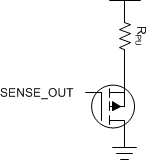SBVS360A February 2020 – November 2020 TPS7B85-Q1
PRODUCTION DATA
- 1 Features
- 2 Applications
- 3 Description
- 4 Revision History
- 5 Pin Configuration and Functions
- 6 Specifications
- 7 Detailed Description
- 8 Application and Implementation
- 9 Power Supply Recommendations
- 10Layout
- 11Device and Documentation Support
8.1.7 Pulling Up the SO and PG Pins to a Different Voltage
Because the sense out (SO) and power-good (PG) pins are pulled up internally to the output rail, they cannot be pulled up to any voltage or wire AND'd like a typical open-drain PG output can be. If these signals must be pulled up to another logic level then an external circuit can be implemented using a PMOS transistor and a pullup resistor. Implementing the circuit shown in Figure 8-10 allows the outputs to be pulled up to any logic rail. This implementation also allows the outputs to be AND'd together like the traditional power-good pins.
 Figure 8-10 Additional Components for the SO and PG Pins to be Pulled Up to Another Rail
Figure 8-10 Additional Components for the SO and PG Pins to be Pulled Up to Another Rail